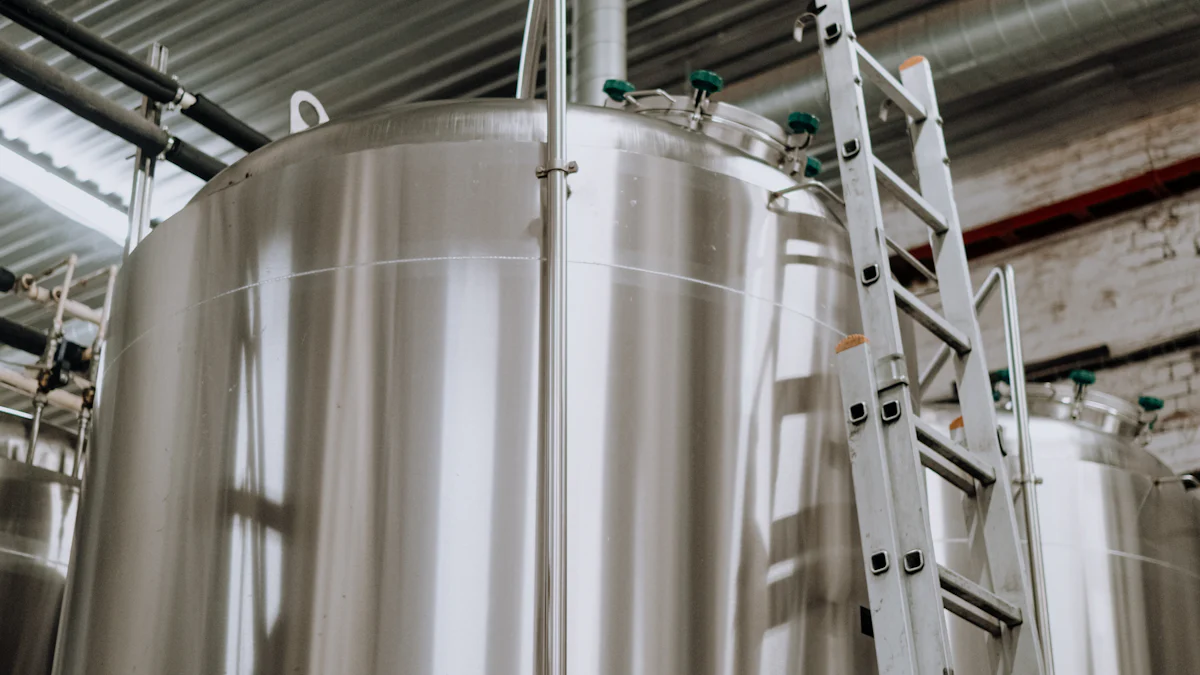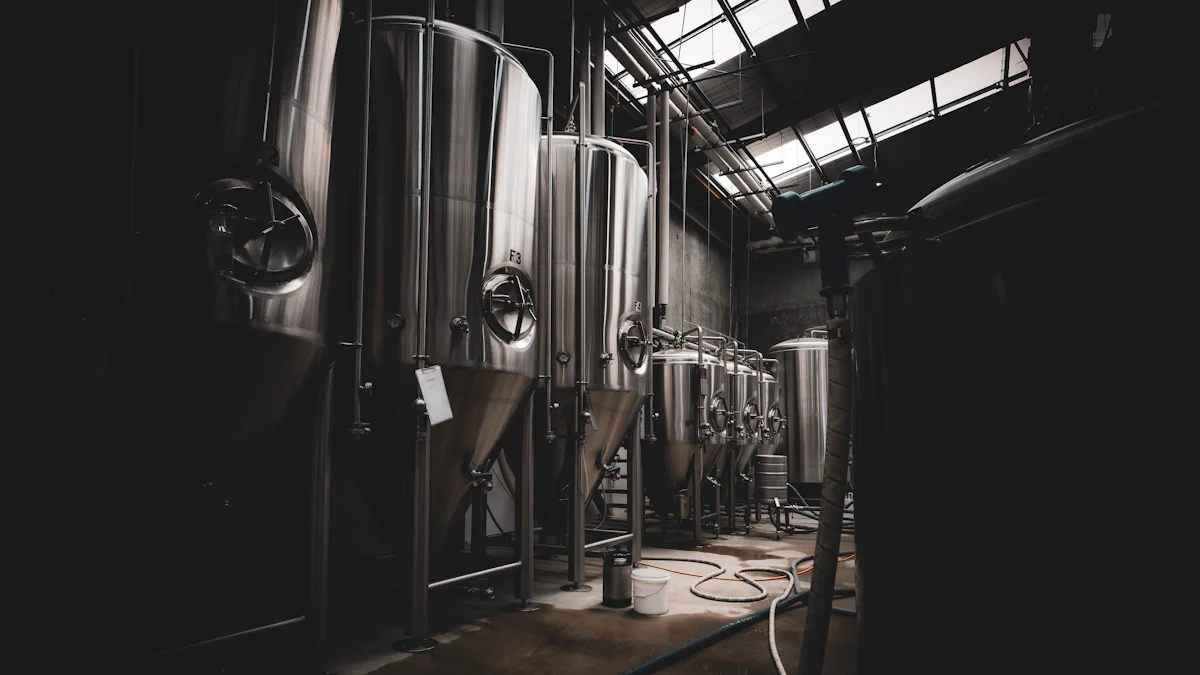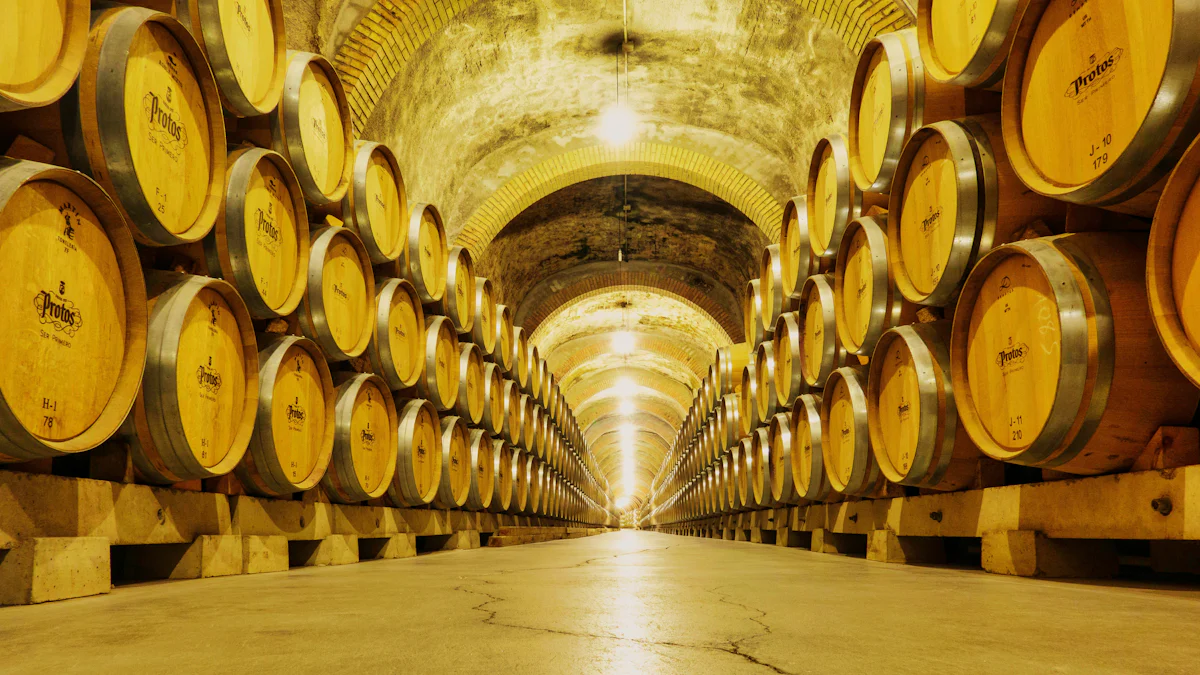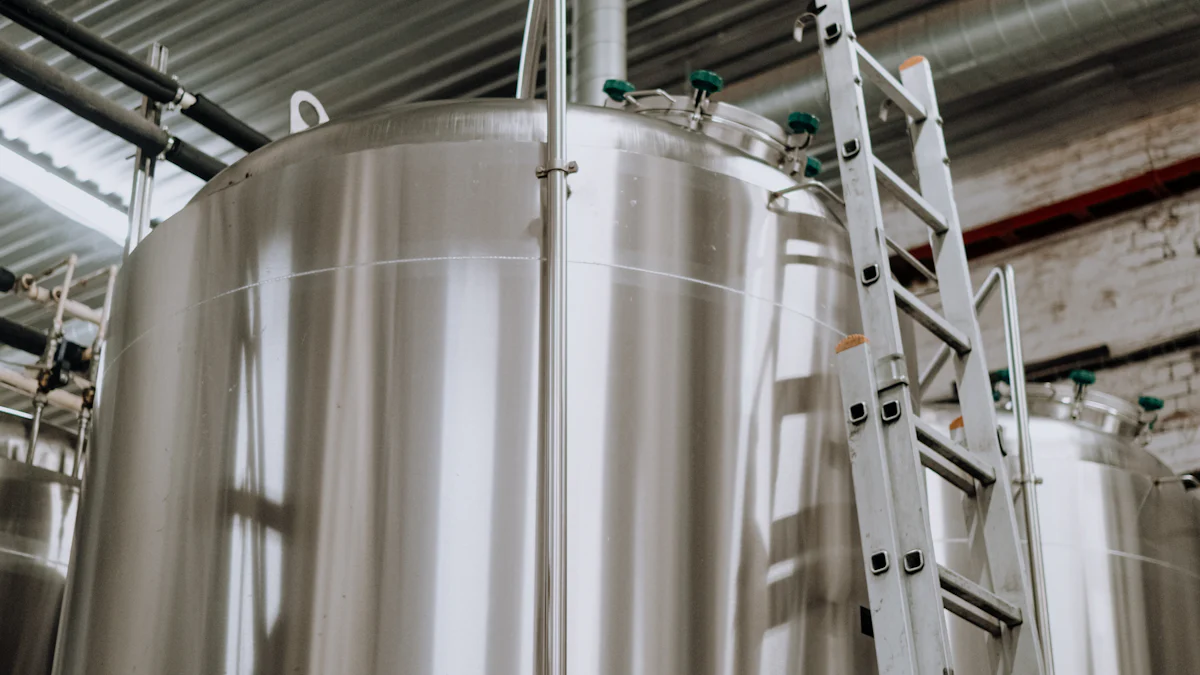
Choosing the right fermentation method shapes the wine’s flavor, cost, and overall quality. In 2025, winemakers face a pivotal decision: stainless steel fermentation tanks or oak barrels. Each option offers unique benefits. Stainless steel fermentation tanks wine delivers crisp, fruit-forward aromas and a fresh taste. Oak barrels, on the other hand, enhance complexity and add rich textures.
Stainless steel tanks excel in durability and cost-effectiveness. They preserve the grape’s natural character without wood influence. Oak barrels, while pricier, impart unique flavors and tannins, making them ideal for red wines or creamy Chardonnays. Your choice depends on your goals and the wine style you aim to create.
Stainless Steel Fermentation Tanks Wine: A Modern Solution

Advantages of Stainless Steel Tanks
Preserving Natural Fruit Flavors
Stainless steel fermentation tanks wine offers a modern approach to preserving the authentic character of your wine. Unlike oak barrels, stainless steel does not impart additional flavors or aromas. This allows the natural fruit flavors of the grapes to shine through. Whether you are crafting a crisp Sauvignon Blanc or a vibrant Rosé, stainless steel aging ensures the wine retains its fresh and fruit-forward profile.
Precision in Temperature Control
Temperature control plays a critical role in fermentation. Stainless steel tanks come equipped with cooling jackets, enabling you to maintain precise temperatures for different wine styles. This precision helps you avoid overheating, which can compromise the wine’s quality. By using stainless steel wine drums, you can achieve consistent results, batch after batch.
Durability and Long Service Life
The durability of stainless steel fermentation tanks wine is unmatched. These tanks resist corrosion from acidic grape juice and maintain their structural integrity for decades. Their smooth, non-porous surface prevents bacterial growth, making cleaning and sanitization effortless. This longevity ensures you get the most out of your investment.
Cost-Effectiveness of Stainless Steel
Lower Maintenance Costs
One of the key benefits of stainless steel is its low maintenance requirements. Unlike oak barrels, which need regular curing and topping off, stainless steel wine drums only require basic cleaning and sanitization. This reduces both labor and material costs, saving you time and money.
Long-Term Savings Compared to Oak Barrels
Over time, stainless steel fermentation tanks wine proves to be a more economical choice. While the initial cost of stainless steel tanks is comparable to oak barrels, their lifespan far exceeds that of barrels. Oak barrels typically last for up to eight fills, requiring frequent replacements. In contrast, stainless steel aging equipment can last for over 30 years without the need for replacement. Additionally, stainless steel eliminates wine loss due to evaporation, further enhancing your savings.
| Item | Oak Barrels | Stainless Steel Tanks |
|---|---|---|
| Initial Cost | $900 – $2,000 | $900 |
| Lifespan | Up to 8 fills (approx. 30 years) | More than 30 years |
| Replacement Cost (30 years) | At least $4,500 | N/A |
| Wine Loss (Evaporation) | Up to 6 gallons/year (30 bottles) | None |
| Maintenance Requirements | High (curing, topping off, etc.) | Low (emptying, cleaning, sanitizing) |
Technological Innovations in 2025
Smart Winemaking Tools Integration
In 2025, stainless steel fermentation tanks wine integrates advanced technology to enhance winemaking precision. Smart sensors monitor fermentation parameters such as temperature, pH, and sugar levels in real-time. These tools allow you to make data-driven adjustments, ensuring optimal fermentation conditions.
Eco-Friendly and Sustainable Features
Sustainability is a growing priority in winemaking. Stainless steel tanks support eco-friendly practices by being fully recyclable. They can be reused indefinitely without losing quality, reducing landfill waste. Their non-porous surface simplifies cleaning, lowering water and chemical usage. Additionally, precise temperature control optimizes energy consumption, minimizing resource waste during fermentation.
Oak Barrels: The Art of Traditional Winemaking

Flavor Enhancements with Oak Barrel Aging
Unique Aromas and Tannins from Oak
Oak wine barrels play a vital role in shaping the flavor profile of wine. The interaction between the wine and the oak extracts compounds like vanillin and tannins, which enrich the wine’s character. Oak adds flavor elements such as vanilla, caramel, and spice, creating a unique sensory experience. The charring or toasting of the barrel’s interior further enhances these flavors. Charring introduces smoky and spicy notes, while toasting develops caramel and vanilla undertones without intense smokiness. This process ensures oak barrel aging delivers a rich and layered flavor profile.
Regional Differences in Oak Characteristics
The impact of oak on wine varies depending on the type of oak used. French oak contributes refined flavors like cinnamon, chocolate, and crème brûlée, along with a creamy texture. American oak offers bold vanilla, roasted coffee, and coconut notes, making it ideal for wines with a sweeter profile. Eastern European oak provides a balance between the two, with flavors influenced by the level of toasting. These regional differences allow you to select oak wine barrels that align with your desired wine style, enhancing aroma complexity and balance.
The Aging Process in Oak Barrels
Micro-Oxygenation and Texture Development
Oak barrels allow small amounts of oxygen to interact with the wine, a process known as micro-oxygenation. This softens tannins and stabilizes the wine, resulting in a smoother texture. The gradual oxygen exposure also enhances the wine’s structure, making it more elegant and well-rounded.
Complexity and Depth in Wine Profiles
Oak barrel aging introduces aromatic compounds that add layers of complexity. Flavors like vanilla, spice, and toast emerge, while tannins from the oak contribute to the wine’s structure and antioxidant properties. Over time, the wine develops depth, showcasing a harmonious blend of flavors and aromas. This process highlights the artistry of oak barrel aging, creating wines with unparalleled richness.
Challenges of Using Oak Barrels
High Costs and Short Lifespan
Oak barrels are expensive to produce due to the labor-intensive process and limited supply of high-quality oak. Each barrel lasts for only up to eight fills, requiring frequent replacements. This makes oak barrel aging a costly choice, especially for small wineries.
Labor-Intensive Maintenance Requirements
Maintaining oak wine barrels demands significant effort. Regular cleaning, curing, and topping off are necessary to prevent contamination from wild yeasts and bacteria. These tasks increase labor costs and require specialized knowledge, adding to the challenges of using oak barrels.
Oak Barrels Versus Stainless Steel Tanks: A Direct Comparison
Flavor Profiles: Complexity vs Neutrality
The choice between oak barrels and stainless steel tanks significantly impacts a wine’s flavor. Oak barrels enhance complexity by introducing flavors like vanilla, caramel, and cinnamon. These flavors come from the oak itself and the toasting process during barrel production. Wines aged in oak often develop a creamy texture, especially when malolactic fermentation occurs. This makes oak barrels ideal for creating rich, full-bodied wines.
In contrast, stainless steel tanks preserve the wine’s original characteristics. They do not add any external flavors, allowing the natural fruit notes to shine. This results in a fresh, crisp taste with vibrant fruit-forward aromas. Stainless steel tanks are particularly suited for white wines like Sauvignon Blanc or Rosé, where maintaining the grape’s purity is essential. While oak barrels provide depth and richness, stainless steel tanks offer a clean and neutral profile. Understanding the pros and cons of each helps you decide which method aligns with your winemaking goals.
Cost Analysis: Initial Investment vs Long-Term Value
The financial aspect of oak barrels versus stainless steel tanks is another critical factor. Oak barrels typically cost between $900 and $2,000 each. However, they require replacement after about eight uses, leading to significant long-term expenses. Additionally, the maintenance and labor involved in using oak barrels further increase costs.
Stainless steel tanks, on the other hand, also start at around $900 but last over 30 years. Their durability eliminates the need for frequent replacements, making them a more economical choice in the long run. Oak barrels may contribute to higher consumer prices for wines due to their cost, but they also add unique flavors that justify the expense for certain wine styles. Stainless steel tanks provide a cost-effective solution without compromising quality, especially for winemakers focused on efficiency.
Durability and Maintenance: Which is More Practical?
When it comes to durability, stainless steel tanks outperform oak barrels. Stainless steel resists corrosion and maintains its structural integrity for decades. Its smooth, non-porous surface prevents bacterial growth, making cleaning and sanitization straightforward. This reduces the time and effort required for maintenance.
Oak barrels, while traditional, demand more care. They require regular cleaning, curing, and topping off to prevent contamination. Their porous nature makes them susceptible to bacteria and wild yeast, increasing the risk of spoilage. Additionally, oak barrels have a limited lifespan, lasting only up to eight fills. Stainless steel tanks offer a practical and long-lasting solution for winemakers seeking efficiency and reliability.
Suitability for Different Wine Styles
Choosing the right fermentation method depends on the wine style you want to create. Stainless steel tanks and oak barrels each bring unique qualities to the table, making them better suited for specific types of wine.
Stainless steel tanks work best for wines that highlight the natural characteristics of the grape. These tanks do not add any external flavors, allowing the fruit’s essence to shine. This makes them ideal for crisp white wines like Sauvignon Blanc or Pinot Grigio. The fresh, fruit-forward taste and vibrant acidity of these wines remain intact during fermentation in stainless steel. Lighter red wines, such as Gamay or Pinot Noir, also benefit from this method. The result is a refreshing wine with a clean profile.
Oak barrels, on the other hand, enhance wines that require added complexity and softness. The interaction between the wine and the oak introduces flavors like vanilla, spice, and caramel. This makes oak barrels perfect for full-bodied red wines such as Cabernet Sauvignon or Syrah. These wines develop a rich texture and layered flavors during the aging process. Creamy white wines, like Chardonnay, also thrive in oak barrels. The barrel aging process adds depth and a buttery finish to these wines.
Tip: If you aim to produce a wine with bold flavors and a smooth texture, oak barrels are the way to go. For a fresh and vibrant wine, stainless steel tanks offer the best results.
By understanding the strengths of each method, you can align your fermentation choice with your winemaking goals. Whether you prefer the crispness of stainless steel or the complexity of oak, the right method will elevate your wine to its fullest potential.
Hybrid Approaches in Modern Winemaking
Combining Stainless Steel and Oak Barrels
Using Oak Chips or Staves in Stainless Steel Tanks
You can replicate the effects of barrel aging in stainless steel tanks by using oak chips or staves. These tools, often referred to as Fan Packs, provide the same flavor impact as traditional barrels. Winemakers attach these staves inside the tank or allow them to float during fermentation and aging. This method delivers the elegance and complexity of oak without the high costs or labor-intensive maintenance of barrels. By using oak chips or staves, you can achieve barrel-like flavors such as vanilla, spice, and caramel while preserving the efficiency of stainless steel tanks.
Partial Fermentation in Both Methods
Partial fermentation and aging in both stainless steel tanks and oak barrels offer a balanced approach. You can ferment part of the wine in stainless steel to retain its fresh, fruit-forward character. The remaining portion can age in oak barrels to gain complexity and depth. Sequential aging is another effective technique. Start fermentation in stainless steel to develop the wine’s fruitiness, then transfer it to oak barrels for aging. This hybrid method allows you to combine the best qualities of both materials, creating a wine with vibrant fruit flavors and rich textures.
Innovations in Oak Alternatives
Oak-Infused Stainless Steel Tanks
Oak-infused stainless steel tanks are an exciting innovation in the winemaking process. These tanks incorporate oak elements directly into their design, allowing you to achieve the benefits of barrel aging without using traditional barrels. The oak infusion introduces subtle flavors and aromas, such as vanilla and toast, while maintaining the precision and durability of stainless steel. This approach simplifies the fermentation and aging process, making it more efficient and cost-effective.
Sustainable Alternatives to Traditional Barrels
Sustainability is transforming the winemaking process. Many wineries now use barrels made from responsibly sourced wood or alternative materials like stainless steel and ceramic. Non-traditional woods, such as acacia, cherry, and chestnut, are gaining popularity for their unique flavor profiles. Hybrid barrels, which combine different wood types, offer even more customization. These innovations allow you to create distinctive wines while reducing environmental impact. By adopting sustainable practices, you can enhance your wine ageing techniques and contribute to a greener future.
Tip: Experimenting with hybrid approaches can help you achieve a perfect balance between tradition and innovation in your winemaking process.
Trends in Winemaking Preferences in 2025
Growing Demand for Flavor Consistency
In 2025, winemakers are focusing more on delivering consistent flavor profiles. You may notice that consumers now expect wines to taste the same across different batches. This demand for uniformity has led to the adoption of advanced fermentation techniques. Non-Saccharomyces yeasts are becoming popular because they create unique flavors while maintaining balance. These yeasts produce diverse aroma compounds, giving you the ability to craft wines with distinct characteristics.
Co-fermentation is another trend shaping winemaking. By combining non-Saccharomyces yeasts with traditional ones, you can enhance the aromatic complexity of your wine. This method allows you to achieve a perfect balance between innovation and tradition. Whether you aim to create a bold red or a crisp white, these techniques help you meet consumer preferences for consistent and high-quality wines.
Sustainability as a Key Factor
Sustainability has become a cornerstone of winemaking. You might already see wineries adopting solar power to reduce energy costs and minimize their environmental impact. This shift reflects a growing commitment to eco-friendly practices. Consumers are also driving this change. Many now prefer wines that are organic, biodynamic, or sustainably produced. These choices align with their values of environmental care and transparency.
Organic farming is another practice gaining traction. By embracing this approach, you contribute to social responsibility while producing high-quality wines. Sustainability is no longer a luxury; it’s an expectation. As a winemaker, adopting these practices not only benefits the planet but also strengthens your connection with environmentally conscious consumers.
The Role of Advanced Technology in Fermentation
Technology is revolutionizing winemaking in 2025. Smart fermentation tools now allow you to monitor key parameters like temperature, pH, and sugar levels in real time. These tools help you make precise adjustments, ensuring optimal fermentation conditions. By using these innovations, you can achieve consistent flavor while reducing the risk of errors.
Oak-infused stainless steel tanks are another exciting development. These tanks combine the precision of stainless steel with the flavor-enhancing properties of oak. They simplify the fermentation process and offer you a cost-effective way to introduce barrel-like flavors. With these advancements, you can create wines that meet modern consumer preferences while staying efficient and innovative.
Note: Staying ahead of these trends can help you align your winemaking process with the evolving demands of the industry.
Choosing Between Stainless Steel Tanks and Oak Barrels
Factors to Consider: Budget, Wine Style, and Goals
When deciding between stainless steel tanks and oak barrels, you need to evaluate several key factors. Each method offers unique benefits that align with different winemaking goals.
- Budget: Stainless steel tanks provide a cost-effective solution. Their durability ensures decades of use without replacement, unlike oak barrels, which require frequent renewal every 2-3 years. This longevity makes stainless steel a smart economic choice.
- Wine Style: Consider the type of wine you aim to produce. Oak barrels enhance complexity and softness, making them ideal for full-bodied reds or creamy whites. Stainless steel tanks preserve crisp, fruit-forward flavors, perfect for Sauvignon Blanc or Rosé.
- Winemaking Goals: Think about your long-term objectives. If you prioritize efficiency and consistency, stainless steel tanks offer precision and reliability. For wines that demand rich textures and layered flavors, oak barrels remain unmatched.
By understanding these factors, you can select the method that complements your wine and aligns with your vision.
Consulting Experts for Tailored Solutions
Navigating the complexities of winemaking can feel overwhelming. Consulting with industry experts helps you make informed decisions tailored to your needs. Professionals can assess your production scale, wine style, and budget to recommend the best equipment.
Experts also provide insights into hybrid approaches. For example, they might suggest using oak chips in stainless steel tanks to achieve oak-like flavors without the high costs of barrels. They can guide you in adopting modern innovations, such as smart fermentation tools, to enhance precision and efficiency.
Seeking expert advice ensures you maximize your resources while achieving your desired wine profile. Their experience helps you avoid costly mistakes and optimize your winemaking process.
Balancing Tradition with Innovation
Combining traditional methods with modern advancements allows you to create exceptional wines while staying competitive. Traditional oak barrel aging adds depth and character, but integrating innovations like oak-infused stainless steel tanks enhances sustainability and efficiency.
Modern technology, such as data analytics and precision tools, improves decision-making. You can monitor fermentation conditions in real time, ensuring consistent quality. Eco-friendly practices, like water conservation and renewable energy, further demonstrate your commitment to sustainability.
Balancing tradition with innovation not only elevates your wine but also aligns with evolving consumer preferences. By embracing both, you honor winemaking heritage while meeting modern demands for quality and sustainability.
The Role of Chenma in Modern Winemaking
Chenma’s Expertise in Stainless Steel Tanks
Customization for Unique Winemaking Needs
Chenma stands out as a leader in crafting stainless steel tanks tailored to your specific winemaking requirements. The company specializes in designing and manufacturing fermentation equipment for the wine and beverage industries. This expertise ensures that every tank meets the unique needs of your production process. Whether you need a tank for small-batch wines or large-scale operations, Chenma offers custom solutions that align with your goals.
You can rely on Chenma to deliver tanks that preserve the natural flavors of your wine while maintaining durability and efficiency. Their engineers adapt designs to suit your preferences, ensuring that the tanks integrate seamlessly into your facility. This level of customization helps you achieve precision and consistency in your winemaking process.
State-of-the-Art Manufacturing Standards
Chenma’s production facility spans 20,000 square meters and employs over 200 skilled professionals. The company uses advanced machinery to create stainless steel tanks that meet the most demanding technical requirements. Each tank undergoes rigorous quality checks to ensure it adheres to international safety and environmental standards.
Chenma’s certifications, including ISO9001-2005 and EU CE, guarantee that you receive equipment built to the highest standards. These certifications reflect the company’s commitment to quality, safety, and sustainability. By choosing Chenma, you invest in tanks that deliver long-term reliability and performance.
Supporting Winemakers with Turnkey Solutions
Process Design and Equipment Installation
Chenma simplifies your winemaking journey by offering comprehensive turnkey solutions. The company assists you with process design, ensuring that your equipment layout maximizes efficiency. Their team handles the installation and commissioning of stainless steel tanks, allowing you to focus on crafting exceptional wines.
This hands-on support ensures that your equipment operates smoothly from day one. Chenma’s expertise in fermentation equipment design and installation helps you optimize your production process, saving time and resources.
Technical Training and After-Sales Support
Chenma goes beyond manufacturing by providing technical training for your team. This training equips you with the knowledge to operate and maintain your stainless steel tanks effectively. You gain the skills needed to troubleshoot issues and ensure consistent wine quality.
The company also offers robust after-sales support, addressing any concerns you may have. Their commitment to customer satisfaction ensures that you receive ongoing assistance, making Chenma a trusted partner in your winemaking journey.
Tip: Partnering with Chenma gives you access to a complete package of services, from equipment design to long-term support, ensuring your success in modern winemaking.
Choosing between stainless steel tanks and oak barrels depends on your winemaking goals. Each method offers distinct advantages:
- Oak Barrels: Add complex flavors like vanilla and spice, enhance texture through tannins, and support malolactic fermentation for a smoother mouthfeel. These are ideal for wine aging in full-bodied reds and creamy whites.
- Stainless Steel Tanks: Retain the wine’s natural characteristics, provide precise temperature control, and offer cost-effective durability. These excel in producing fresh, crisp wines like Sauvignon Blanc.
Aligning your fermentation method with your goals ensures the best sensory profiles and production efficiency. Hybrid approaches, such as using oak chips in stainless steel tanks, combine tradition with innovation for optimal results. Consulting experts like Chenma can further tailor solutions to your unique needs, from custom equipment design to technical training.
Tip: Balance tradition and modernity to craft exceptional wines that meet evolving consumer preferences.
FAQ
What are the main differences between stainless steel tanks and oak barrels?
Stainless steel tanks preserve the wine’s natural fruit flavors and offer precise temperature control. Oak barrels enhance the wine with complex aromas like vanilla and spice. Stainless steel suits fresh, crisp wines, while oak barrels excel in creating rich, full-bodied wines.
Can you replicate oak barrel flavors in stainless steel tanks?
Yes, you can use oak chips or staves in stainless steel tanks to mimic wood fermentation effects. These additions introduce flavors like caramel and spice, enhancing the wine’s tasting experience without the high costs of traditional barrels.
How does sustainability factor into choosing fermentation methods?
Stainless steel tanks support sustainability by being recyclable and reducing water usage during cleaning. Oak barrels, while traditional, require more resources to produce and maintain. Choosing stainless steel aligns with eco-friendly practices and modern winemaking trends.
Which method is better for white wines?
Stainless steel tanks work best for white wines like Sauvignon Blanc. They retain the wine’s crispness and vibrant fruit-forward aroma. Oak barrels, however, suit creamy whites like Chardonnay, adding depth and a buttery texture.
Is it possible to combine both methods in winemaking?
Yes, you can ferment part of the wine in stainless steel to preserve freshness and age the rest in oak barrels for complexity. This hybrid approach balances tradition with innovation, creating a unique wine profile.



